Chauncy
Frost
8 October 1866 – 13 May 1930
Less than two years after the Mormon Pioneers entered the Salt Lake
Valley, Ute chiefs Walkara and Sowiette went to the Salt Lake Valley on June 14, 1849 to ask
Brigham Young to settle a group of his people in the valley of Sanpitch, about 125
miles to the south. Wanting to honor their request and needing to
found new settlements where the quickly-growing population of the
Utah Territory could expand, Brigham Young sent a party to explore
the area in August of that year. It was deemed favorable to
settlement, and Brigham Young called Isaac Morley to organize
about fifty families to move south and settle "San Pete."
The settlers arrived in the valley on 19 November 1849. They numbered 224 men, women, and children and were led by Isaac Morley, Charles Shumway, and Seth Taft. After some debate, the first settlement in the valley was established on the present site of Manti, Utah.
Looking for locations for other settlements in the Sanpete Valley, in 1852 James Allred and his sons were sent from Manti to settle in Canal Creek. With so many Allreds in the area, it isn’t surprising that the first name was the Allred Settlement. With the outbreak of the Walkara War hostilities in July 1853, the settlers of Hambleton on Pleasant Creek retreated to the Allred Settlement. The settlements were sacked, and settlers removed to Manti. When they finally returned in 1859, they agreed on the name Spring City. It’s an appropriate name, because of the spring in the center of town.
As Spring City became established, more settlers moved down from the Salt Lake Valley. Of these were Samuel Buchanan and Ester Davis Frost, who arrived in the area around 1864. They had only recently been married. Three of Samuel's children from his first marriage, Hettie age 19, Samuel Jr. age 15, and James age 12 came with them. In Spring City, Samuel farmed extensively and owned a fine home for the times. He also did cabinet work, blacksmithing, and even shoe repair. Their first child Stephen was born in Spring City on April 1, 1866.
Chauncy Frost was born 8 Oct 1866 at Spring City, Sanpete, Utah He was named Chauncy by his mother, but he never used the name, instead he went by Chancy. He was the second child in the family of seven children. The other children born to his parents were: Rebecca Pennina, 26 Sept 1868; Adolph Leseau, 5 Aug 1870; Margaret Elizira, 30 Sept 1872; Ivan Danzoff, 9 Jan 1875, and Marion, 12 May 1878.
Chancy went to school only a year or two in Spring City. Although they did use notebooks, they mostly used slates. They studied reading, writing, and arithmetic. Chancy was very good at arithmetic. The Frosts were a religious family where they were active in church and had family prayer. Economically, they had a good living most of the time.
Chancy left home when he was about 14 or 15 years old and worked at shearing
sheep. He learned to tan hides from Sally, an Indian squaw. He moved
with his family to Coyote in Garfield County in 1888. About a month
later, his father died on June 27, 1888.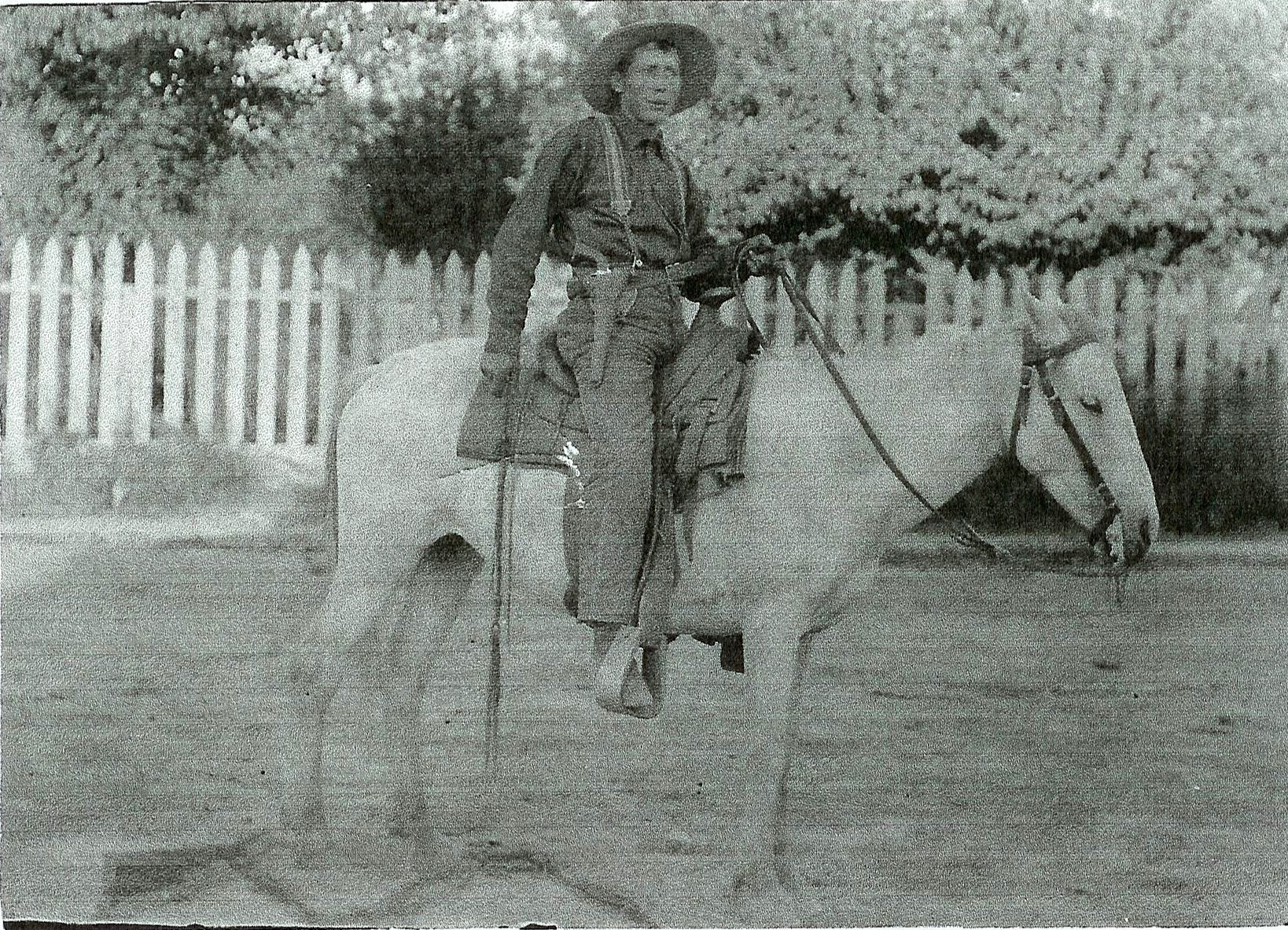
Chancy as a young man on horse back, notice the pistol he is wearing.
Chancy met LaNeva Warner while both their families lived in Coyote (now
Antimony) Utah. They were married at the home of his parents on
September 30, 1890. Chancy's sister, Margaret, and LaNeva's brother,
Wallace, were married at the same time as Chancy and LaNeva. 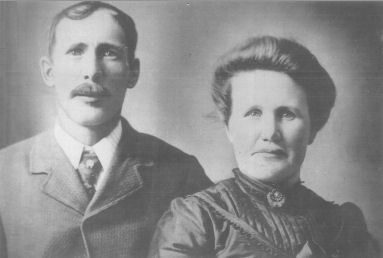
Chancy and LaNeva Frost
Both couples traveled to Manti, Utah on April 1, 1891 to receive their Endowments and be sealed for time and eternity. Stephen and his wife Josena Jensen, also went to Manti and were endowed and sealed at the same time. Stephen, Chancy and Margaret were also sealed to their parents at that time.
Chancy and LaNeva shared a house with Wallace and Margaret for a time before their first child was born. They each had a baby boy who were born close to the same time.
The first seven children born to them were born in Coyote, Garfield, Utah. The children were: Ira L, 11 Sept 1891; Elva Martina, 28 July 1893; Nettie, 13 Aug 1895; Cora Priscella, 19 Apr 1898, Nancy Faye, 26 Sept 1900; Christena, 12 Nov 1902; and Florence Valera, 29 Mar 1905.
In Coyote, Chancy and LaNeva lived in a one-room log house with two windows and one door. It was a big house for those times, 18 feet by 20 feet. Chancy engaged in farming, raising livestock, and sheep herding.
In 1891 Chancy traveled by wagon to Manti with his mother to do the
temple work for Henry Wadsworth Longfellow. He was baptized by proxy
for him and performed the endowment. Then in January 1893 they
returned for the sealing. Chancy acted as proxy for Mr. Longfellow
and Ester was the proxy for his wife. Ester had worked in the home of
the Longfellows after coming to America and before coming to Utah.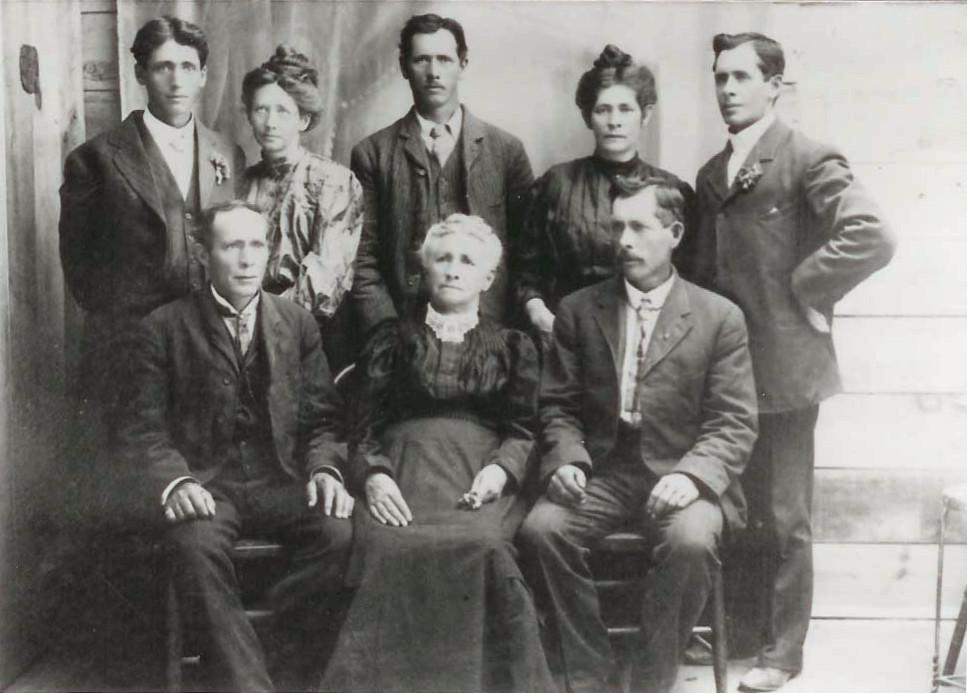
The Samuel Buchanan Frost Family: Back: Marion, Margaret, Adolph, Rebecca, and Ivan
Front: Chancy, Ester, and Stephen
People of those days enjoyed square and round dancing. There was very good fishing and hunting. Deer was the main game hunted, and it was nothing to see twenty head in a herd. There were also wild chickens. Girls and boys both enjoyed riding horses, but girls rode side saddle. Boys and men of all ages enjoyed playing marbles. (No wonder Ira had such a large collection of marbles.) Horse racing was a favorite sport of Chancy's and nearly everyone had race horses. Chancy broke his own horses. His hobby was his dog, whichever dog he happened to own.
In 1908, several families moved to Marion, Idaho. Chancy and LaNeva and family; Wallace and Margaret and family; Stephen and Josena and family; and their mother, Esther.
Chancy went to Idaho in the spring of 1908 and stayed until fall. Then he
took his family and went back in the fall of 1908. They loaded their
household goods in two wagons in Coyote and went to Manti. Ira
started a day before the rest of the family and drove the cattle to
Manti, where they were put on the train. The livestock and furniture
went to Pocatello, Ira and Chancy had a bed in the car with the
stock. There were about four horses, they took up about half a box
car with the furniture in the other half. In the meantime, LaNeva and
her six daughters went on the train right to Burley. After the
household goods, animals and people were on the train. Chancy's
brother, Marion, drove one of the wagons, trailing the other behind,
and went back to Coyote from Manti.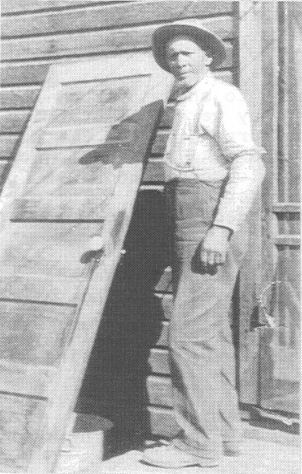
Chancy
Chancy and Ira lived by the stockyards in Pocatello until LaNeva's brother, Wallace Warner and his son Deloss arrived with a couple of teams and wagons. (Apparently, the Warner family had already moved to Idaho.) There were a lot of hobos in the freight yards in Pocatello. who would ask them where they were going. Upon receiving the answer, they would say, "Oh, don't go there, It's too cold."
The household goods were loaded on the wagons for the trip to Marion, which is near Oakley. Chancy, Ira and Deloss drove the cattle from Pocatello to Marion, a distance of about one hundred miles, on horseback. Chancy probably drove one wagon and Wallace the other. It was a miserable time on the trail, as it was November and the weather was cold. Chancy and Ira didn't see the rest of the family until they were reunited in Oakley.
The family had gone on ahead and had rented a house on a ranch. Chancy and Ira arrived in Oakley the forepart of December with the cattle. They were two weeks on the road, part of the time spent in waiting.
They left Utah and moved to Idaho because it seemed to offer new opportunities. Everyone had "Idaho Fever." LaNeva told her daughters that they would have no one to marry if they had stayed in Utah. Most of the people they knew seemed to be related to them.
Chancy received some sheep as part of the price for his place in Utah. He went to work for a gentleman who had a large band of sheep. This man suggested that Chancy could put their sheep together. This turned out to be a disaster for Chancy. The man ended up with all of the sheep. Because Chancy was an honest man, he was an easy mark for a dishonest person.
Esther, their mother, lived until December 26, 1910 and was buried at Marion, Cassia, Idaho. Before her death she was very ill but she prayed she would not die on Christmas Day because she did not want to spoil Christmas Day for the children. Her prayers were answered and she lived until the day after.
While in the same area, Chancy took care of some bees for a man. He got a
certain amount of the honey for his pay. He kept whatever share was
agreed upon. The owner said he had never received so much honey from
anyone who had cared for the bees before.

The cabin on Chancy's homestead. That is him standing
in the door.
In Oakley, three more children were born to Chancy and LaNeva: Earl Warner, 4 May 1910; Delilah Pearl, 22 Jan 1912; and Ruby Geneva, 16 Dec 1916.
Chancy loved children, especially babies. When the family lived in small communities, Chancy would walk a long ways just to see a new baby.
When Chancy saw some of the kids doing something they shouldn't, he would
say to LaNeva, "Go give that kid a damn good lickin" and
away she would go and get the job done. One day as she started out,
she stopped and said, "If you want that kid to have a lickin,
you give it to him." Chancy grinned and got up, took his hat and
left the house.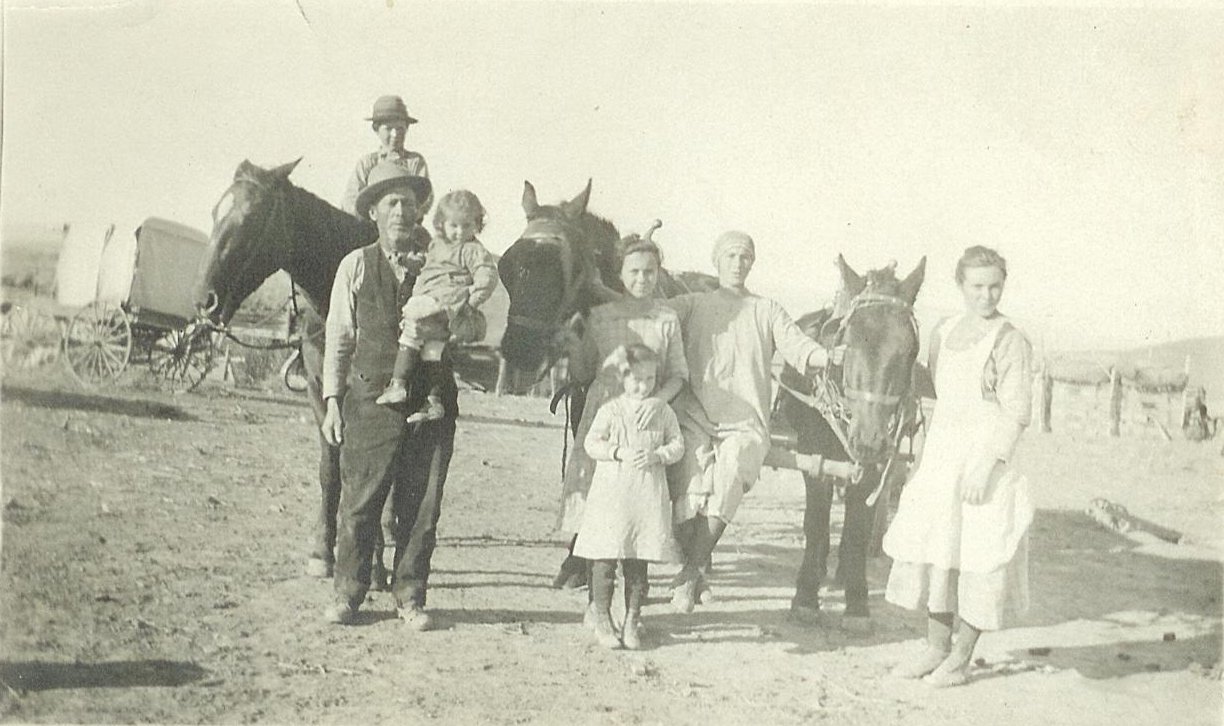
Earl (on the horse) Chancy holding Ruby, Florence, Faye,
Christena, and Pearl.
One time he decided to teach Florence and Christena a lesson and took a switch to them, over their long skirts, of course. Boy did they howl and bawl, until they got behind the barn. Christena asked Florence, "Did that hurt you?" The answer was, "No." They thought they had really fooled him but he knew exactly what he was doing.
Chancy and Ira each filed on dryfarm land in Boulder, Cassia Idaho. It was
about twelve miles north east of Oakley. The mailing address was
Boulder but the land was really in Land Canyon. The two canyons met
just northwest of Chancy's house. The mail was delivered to boxes set
up close to the one-roomed school house about two or three miles west
of the farm. Chancy's portion was partly rangeland and Ira's was all
range. Ira's was right on the east of Chancy's quarter section. They
named their land the Land Ranch. Each built log cabins, about 18 by
15 feet, on their land. Chancy had three streams, all his own. right
next to the foot hills, and had all the land he wanted to fence in. 
Sheep herder
They didn't do much farming because there was not much of a market for farm goods at the time, so Chancy worked for wages to make a living. He had a few cows and a few horses.
Chancy had an almost constant companion in his son and firstborn child, Ira. Before Ira went into the Service in World War I and later married, they always seemed to do things together. They worked one winter hauling rock to build the Goose Creek reservoir.
Chancy and Ira went out shearing sheep every spring around Three Creek and around Oakley. Chancy was quite adept at shearing sheep. At first they used hand sheers but later used battery operated sheers. When first acquired, Chancy was going to show off his new fangled outfit to his girls. They were all standing around him in a semicircle and when he turned on the machine, Cora was going to touch him on the neck and make a noise to scare him. It turned out, all the girls were touching and when Cora put her finger on his neck, he really got zapped. The girls barely felt the shock. He may have intended to shock them, no one knew.
They hauled wood and posts out of the hills from south of the Goose Creek Dam west of Oakley. All of the sawing was done by hand. The top quality poles were sold, while the remainder of the wood was used for cooking and heating the house in the winter.
Winters were very severe in the mountains so a house was rented closer to school. One house that they rented belonged to a bootlegger who had moved to a different place. The house was built for the purpose of hiding the merchandise. The wallboards were removable and between the studs were shelves. The flat whiskey bottles used then, would just fit in side-ways and a lot of bottles could be stored. Another house was owned by a bachelor.
The winter the family lived there, it snowed for weeks, and being so
cold, the snow froze hard and was higher than the fence posts. The
kids just walked through the fields to school, single file, the
oldest first and the youngest bringing up the rear. Their scarves
tied around their faces but it did not help much, their breath froze
on the scarf. A new trail had to be made each day because it snowed
every night. This is where the family lived when Ira came home from
World War I.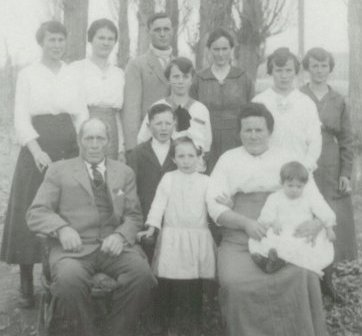
The Frost Family – 1917 Back row: Faye, Cora, Ira,
Nettie, Christena, and Elva. Middle: Florence.
Front row: Chauncy, Earl, Pearl, Lonevie, and Ruby.
The summer of 1920, Florence, Earl, Pearl and Ruby spent the time with Chancy while LaNeva went to Burley which is north of Oakley some twenty-four miles. She went looking for a house to move the family to and to try to get employment. They lived in Ira's house at that time.
They first lived in a two family house on Yale Ave in Burley. Rebecca and Pete Nelson, Chancy's sister and family lived in the other part. They later moved into a house on 9th street. Then a house was purchased on Schodde Ave and by then Florence had married Fred Peterson and they bought the house on 9th Street.
When the family first moved to Burley, there were not many houses around
the neighborhood and the family kept a cow and a horse staked on the
vacant lot around for a long time.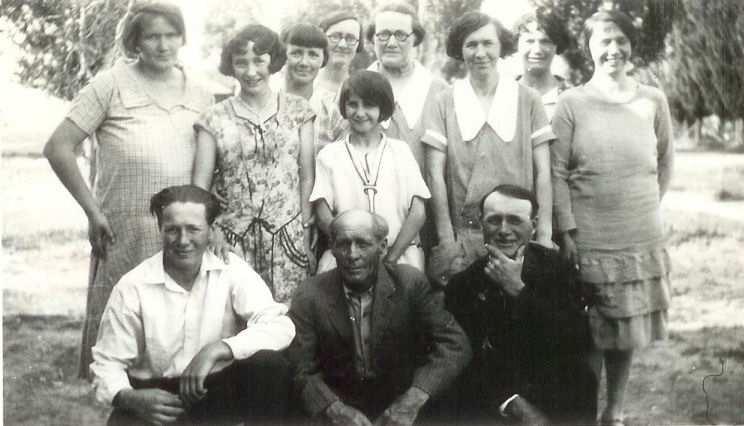
The Chauncy Frost Family -
about 1927 Back row: Christena, Pearl, Elva, Nettie, Lonevie, Faye, Cora,
and Florence. Middle: Ruby.
Front: Earl, Chauncy, and Ira.
Chancy would live at the dry farm in the summer, leaving his family in Burley, and take care of his cattle and horses. The ranch was finally sold for little profit and then he herded sheep for other men, living in a little horse-drawn “sheep wagon' with only his sheepdog for company, miles away from any other person.
After moving to Burley, Chancy also worked at the sugar factory during the
"campaign" for two or three winters. During this time,
there was always plenty of brown sugar candy in the house. 
Ira, Chancy, and Earl in 1929
In 1929, Faye was cooking on a big cattle ranch in Nevada near Hallock, The McIntire Ranch. Bill Olson, Faye's husband at the time, was foreman. Chancy, Earl, and Pearl went down to work for him. Chancy sharpened mower knives, Earl drove a slip to haul hay and Pearl helped Faye in the kitchen. They were harvesting wild meadow hay and the job lasted about six months.
Chancy was not well and didn't work for quite awhile before his death, but he spent his time at home and not at pool halls etc. He tended Faye's kids, especially Jack, the youngest.
Chancy used to sit on a "stool" (actually an old chair with the back broken off) between the coal stove and the door to the living room and teased and grabbed any child that came near. He sometimes went to Ira's farm and helped with the farm work.
Chancy caught pneumonia early in the spring of 1930. Towards the end, different people sat up nights with him to relieve the family members. Vyla, Ira's wife, fed Chancy his last meal before he died at home on May 13, 1930, a very rainy day, at the age of 63. He was buried May 18, 1930 at the Heyburn Cemetery in Heyburn, Minidoka, Idaho. It is just across the Snake River from Burley.
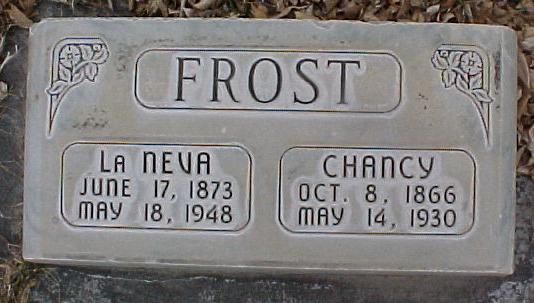
Historical information about the Sanpete Valley and Spring City is from the
Sanpete County Historical Society.
The main story is from a history compiled by Celia Frost Gilmour;
November 1994 taken from personal interviews with LaNeva and and
history notes from Delilah Pearl Frost Ingram and Eunice Frost Read: